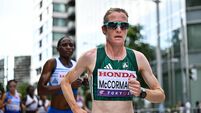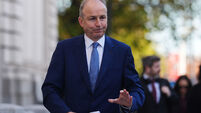What will Grand Slam Track do for athletics?

Sydney McLaughlin-Levrone storms home to win a gold medal and set a new world record in the 400m hurdles final at the Paris Olympics. Picture: ©INPHO/Morgan Treacy
One competitor was in danger of lapping the field. In the race for attention stateside, American football is way out in front. Track and field lay just above an asterisk.
Since 1972, football has topped Gallup’s annual poll. Last year, 41% of respondents said it was their favourite sport, over 30% clear of the nearest contender. Track and field finished level with gymnastics and wrestling at 1%. Swimming was even further behind, beside the sports marked with * for less than 0.5%. Four years out from LA 2028, the major Olympic codes are keen for popularity. Michael Johnson is out to deliver it.
In 2024 the USA sprint great and former four-time Olympic champion launched Grand Slam Track. A global professional track league, Johnson promised to pit the best against the best at four annual Slams. That structure is modelled on golf and tennis. The rest is their own design.
A quick explainer: there would be six men’s event groups and six women’s. Four big-name racers are assigned to each event group and four challengers will fill the other lanes. All contestants will race in two events. The challengers can qualify as a racer for next season.
Each announcement has generated its own bit of excitement. American star Sydney McLaughlin-Levrone, 200m gold medallist Gabby Thomas, the full 1500m men’s podium of Cole Hocker, Josh Kerr and Yared Nuguse. Johnson has built it and they have come.
The three-day events will run on a points system. So, say an athlete enters the Long Sprints event group. It means racing in the 200m and 400m. The winner will be whoever has the highest points across both and can bag $100,000. Payments are staggered down to last place, who will receive $10,000. Their singular focus is rivalry in racing.
“The best competing against each other. That is what is compelling about the biggest sports in the world,” stressed Johnson during his promotional blitz. Big-name signings have continued to build the hype. The first event takes place in April, with three of the four scheduled for the United States, including Los Angeles’ Drake Stadium.
For athletics enthusiasts, the league has the potential to be a solution to so many of their troubles. There is always a demand for more high-level racing. Outside of the Olympics, the Diamond League should be one of the biggest events in the track and field calendar, but some of the world’s best don't turn up.
There will be no field events. For Johnson, they are trying to manufacture stars. That means one event at a time, everyone gets a chance to shine. In a two-and-a-half hour television window, there isn’t enough space to cater for both.
That is part of the problem. On their website, the new league claims TV conversations “are going good – really good.” Johnson has told followers on social media negotiations are nearly complete. They do not currently have a partner. Olympic 100m champion Noah Lyles said he wouldn’t sign without a TV deal. For fans, this is the absolute priority.
Right now, a significant portion of live events are available thanks to the FloTrack subscription model. The same existential concerns that accompany any pay-per-view system are only exaggerated when it is a niche sport. How can you grow an audience beyond those already interested if you have to pay for it? This is the catch-22. Streaming at tracks can be expensive. Charging for them cuts off new fans. Johnson has vowed that GST will be seen. Getting his show into the mainstream before a race has been run would mark a significant success.
“TV Announcement coming later this month,” he recently posted. “The objective was to make it most accessible, easy to find and entertaining. I think fans will be pleased.”
His second task is to bring together a fractured field. On X, Lyles recently posted that their schedule might not fit his. “Unfortunately, the track meet (Kingston) is already in a weird spot for my training.”
Irish star Rhasidat Adeleke offered a similar reason pre-Christmas for her decision not to opt in.
“Michael had talked to my coach and my agent, but Flo just didn’t see a fit for us, so he just decided to wait and see how things work out.
“It is a different season already, so we didn’t want to add too much.”
Adeleke’s peers Marileidy Paulino and Salwa Eid Naser have already signed up as racers. Four set showdowns between the top 400m women would do wonders for their appeal and the sport.
Grand Slam Track athletes can still run in global meets but to break the mould, they need rivals to come together. That means bringing Jakob Ingebrigtsen in with Kerr and Hocker. McLaughlin-Levrone versus the unsigned Femke Bol.
“Of course, there are some recognisable names who haven’t signed as Racers this year,” said Johnson.
“Many of them have indicated their intent to compete in 1, 2, or even 3 of our slams. We are in constant contact with all the fastest athletes and will be working to get them signed on as Challengers.”
Track’s issue isn’t so much demand as it is supply. To truly deliver on what is promised, it will take everything. And everyone.











